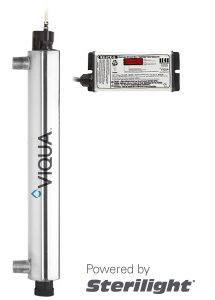
Ultraviolet Germicidal Lamps, or more commonly called UV lights, are very effective at killing bacteria and viruses. UV light disinfection is not a new technology and found its first use in medicine by Niels Fensen in 1903 to fight tuberculosis. Shortly after in 1910, the first UV Disinfection System for water treatment was implemented in Marseilles, France.
What Is UV Disinfection System?
An UV disinfection system is a water treatment method to kill dangerous waterborne pathogens. It harnesses that same power as the sun and uses a specific wavelength of non-visible light creating ultraviolet radiation. The UV radiation that the sun produces can be divided into three main groups: UV-A, UV-B, and UV-C. The ultraviolet (UV) water purification technology uses UV-C which is the shortest of all the UV wavelengths and it most effective at the 254 nm range.
How Does UV Disinfection Work?
Ultraviolet disinfection systems use a short wavelength on light between 200-300 nanometers that penetrates microbes and attacked the nucleic acids and disrupting their DNA. When these vital cellular functions are unable to perform, the microbe can not replicate and is considered inactive or dead. All suspended matter must be removed for UV water disinfection as the light must come into direct contact with the microorganism. Otherwise, the shadowing effect could allow some pathogen to pass by being unaffected.
Applications of UV Disinfection System
UV disinfection systems are used in ventilation systems for airborne pathogen control. Remote robotics are also used for surface/air sanitation in healthcare. Medium-pressure UV disinfection systems are currently used for wastewater treatment. Similar systems also being considered by the dairy industry for waste milk and other applications. The most commonly used ultraviolet (UV) water purification systems are of the low-pressure variety for residential and commercial applications.
Benefits of UV Disinfection System
UV lights are the most popular sanitation method for residential applications because of the minimal cost and low maintenance. The process does not alter the chemistry of the water, change the taste of the water, nor create any harmful disinfection byproducts (DBPs). Perhaps the greatest benefit of the ultraviolet disinfection system is there is no handling of toxic chemicals compared with traditional methods of water sanitation.
Is UV Safe?
A UV Disinfection System for Water Treatment is perfectly safe. If one is performing maintenance on their ultraviolet (UV) water purification system, make sure the unit is unplugged as starring directly into the light can cause damage to one’s sight.
UV System Maintenance
An ultraviolet disinfection system require very little maintenance. These systems run continuous and the bulbs will have to be replaced annually. Most systems have an alarm that will remind you when the maintenance is due. It is important to pretreat the water before the UV light to prevent the quartz sleeve from scaling over. If this pretreatment is not utilized, then quarterly cleaning of the quartz sleeve may be required for your ultraviolet disinfection system.
If you have questions on applications or sizing for UV water disinfection, please contact Intec at 800-896-1759 for a free consultation.


